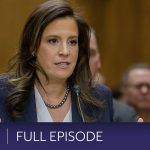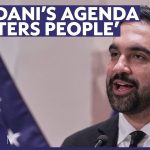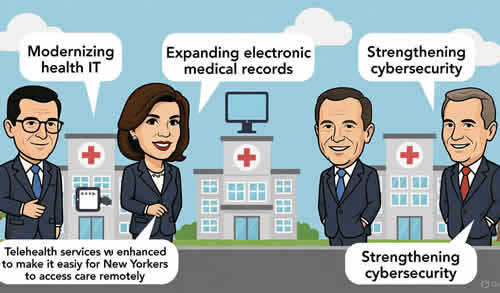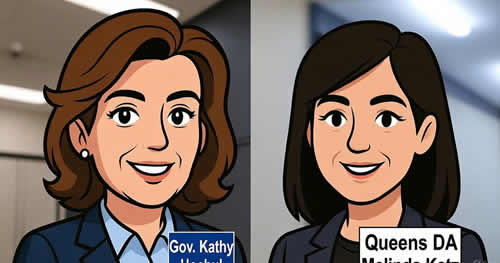Governor Hochul, representing New York and the U.S. Climate Alliance, signed the Planetary Protocol for Climate Change Resilience at the Vatican Climate Conference, emphasizing the global need for urgent action to address the climate crisis and protect vulnerable communities. New York’s climate agenda, including ambitious targets for emission reductions and significant clean energy investments, underscores the state’s commitment to a just transition towards a sustainable future while creating jobs and prioritizing disadvantaged communities.
The Planetary Protocol for Climate Change Resilience Recognizes Need for Prompt and Unified Action to Protect the Most Vulnerable and Address the Climate Crisis
Governor Hochul, Chair of The U.S. Climate Alliance, Delivered Remarks on New York’s Bold Climate Resiliency Plans During Vatican Climate Summit
Planetary Protocol for Climate Change Resilience Here
Photos of Vatican Climate Conference Here
Governor Hochul announced New York has signed on to the Planetary Protocol for Climate Change Resilience, an international agreement between heads of cities, towns and governorates developed as part of the Joint Summit on Climate hosted by the Pontifical Academy of Sciences and the Pontifical Academy of Social Sciences. The Protocol reiterates the need for unified global action to address the climate crisis and protect the most vulnerable.
“We have a moral obligation to leave this extraordinary planet better than we found it,” Governor Hochul said. “From hurricanes to heat waves, New York has experienced the devastation of the climate crisis. Through coordinated action with our colleagues from across the globe, we will continue to move towards a more resilient future.”
The Governor signed the Planetary Protocol while attending Pope Francis’ 3-day joint Summit “From Climate Crisis to Climate Resilience.” Today, the Governor delivered an address on “Climate Leadership in the Empire State: Building Resiliency for All.” Last week, Governor Hochul was appointed as a Chair of the U.S. Climate Alliance, a bipartisan coalition of 24 governors advocating for bold climate action.
The Planetary Protocol for Climate Change Resilience states:
We call for the creation of a Planetary Protocol for Climate Change Resilience, endorsed by experts in both the sciences and social sciences and, crucially, by those in direct service to the communities of the world, including mayors and governors. We are committed to the immediate implementation of these critical measures:
- A One-Earth approach is needed to guide urgent action and speed up policy change and implementation. It is imperative to acknowledge the fundamental right of every individual to climate change resilience.
- We are dealing with separate but interconnected systemic challenges: climate change, large-scale biodiversity loss, environmental pollution, global inequity, and food insecurity. These issues, if not addressed collectively with great urgency, pose existential threats to humans and other living beings, as well as the ecosystems they depend upon. Poor people will be the most adversely affected.
- We recognize that the climate crisis will get worse in the near-term, even if the most optimistic mitigation actions to bend the emissions curve are put into place now. Emissions already present in our atmosphere, will cause suffering that socio-political inertia will extend. We need both a short-term plan (a sprint over the next 25 years) and a long-term plan (a marathon over 25 to 100 years).
- Bend the warming curve down rapidly, and rebound to sustainable living to survive and thrive in ways that are just and lasting. Global cooperation is essential, since emissions anywhere is global heating everywhere.
- We advocate for a swift, multifaceted approach to climate resilience: rapidly reducing emissions, adapting to current climate shifts, and implementing innovative financing mechanisms. This effort demands global cooperation to address, for example, anticipated large-scale migrations, immediate behavioral shifts to cool the planet, transformative education, and ocean and land restoration.
- Wealthy nations and the global affluent must empower the poorest three billion, who contribute least to climate change, with access to clean energy, water, food, and air. These actions will contribute to climate justice and peace, locally and globally.
- We recognize that healthy natural systems underpin our physical, social, and economic resilience, and advocate for urgent action to scale implementation of nature-based climate solutions.
- We acknowledge that the architecture of the P2C2R must be built on the three-pillar MAST principle, as described in COP-28 statement of PAS and PASS. The details of MAST such as its core elements are given in the extended version of this protocol.
- Doing everything in our power to rapidly reduce global greenhouse gas emissions and bend the warming curve by 2050 to limit temporary overshoot to below 2°C and to limit the warming to 1.5°C as soon as possible, is the first pillar of MAST… and also prioritizing nature-based solutions in the proactive removal of CO2 from the atmosphere.
- Adaptation to unavoidable climate change is the second pillar of MAST. Adaptation has three objectives: reducing sensitivity to climate change, reducing exposure to climate threats, and enhancing adaptive capacity. However, there are limits to human and ecosystem adaptations, and to stay within these limits, adaptation must be tightly integrated with mitigation. Crucially, adaptation must be prioritized equally with mitigation and requires action, across all sectors and levels of society. Adaptation efforts should include a focus on public health, including mental health and well-being, along with the flourishing of other living beings and ecosystems – a critical priority in the design of adaptation, solutions under P2C2R. Adapting to heat stress is essential to avoid large numbers of deaths in the coming decades.
- Societal Transformation is the third pillar of MAST, which is essential for thriving in a sustainable future after surviving the crisis. Societal Transformation involves fundamental shifts in behavior, including consumption, and in socio-economic systems and governance. In Pope Francis’ words, “This transformation is akin to an ecological conversion.” The climate crisis presents us with an unparalleled opportunity to build a stronger, healthier, and more just world that reflects the fact that our thriving depends on the well-being of the natural world and other living beings.
- This transformation requires climate literacy for all, from children to adults; access to affordable energy, clean air and water, and education for the poorest three billion people on the planet so they can adapt to climate disasters and thrive in a post-global warming world; public-private partnerships to finance both mitigation and adaptation; provision of skills and training, to allow all access to the jobs needed to deliver these changes, and partnerships with faith-based institutions to garner strong public support for climate actions.
- Planning and policy initiatives must adopt and include child-centered approaches to fostering resilience.
- Comprehensive environmental and sustainability education should be integrated into school curricula worldwide, ensuring that all children develop a deep understanding of ecological issues, sustainable practices, and their roles in fostering a sustainable future from an early age. This should include the promotion of attitudes that encourage responsible stewardship of the planet, critical thinking about environmental challenges as well as preparation for future careers in sustainable industries.
- We must urgently transition from fossil fuel energy to clean energy.
- Harmful subsidies for fossil fuels must be shifted to support actions that can rapidly bend the warming curve, improve universal health coverage, facilitate public transportation, reducing air and water pollution, provide healthy food choices, and promote equity.
- A firm commitment must be made to sustainable agriculture so as to rapidly bend the warming curve, promote equity and offer healthy food choices.
- Behavioral change in people, communities, and the private sector must be rooted through a new global initiative to educate everyone from childhood to old age.
- Researchers and policymakers working on solutions should adopt evidence-based trans-disciplinary collaborations that involve mayors, governors, and local NGOs to manage the resources available at various levels of government.
- Climate change is global, impacts locally, and requires local action. Therefore, we call upon heads of nations to facilitate stronger voices of mayors and governors in global climate policy.
The need for a profound societal transformation across the global population is immediate and critical. Our aim is to enlighten and galvanize societies worldwide into prompt, unified action against climate change and for climate resilience. Our strategy is comprehensive, spanning policy shifts, education, and behavioral changes under the banner of MAST. This is a pivotal moment that calls for unwavering commitment and immediate action. We must capture this moment and transition to a benevolent era with no one left behind.
New York State’s Nation-Leading Climate Plan
New York State’s climate agenda calls for an orderly and just transition that creates family-sustaining jobs, continues to foster a green economy across all sectors and ensures that at least 35 percent, with a goal of 40 percent, of the benefits of clean energy investments are directed to disadvantaged communities. Guided by some of the nation’s most aggressive climate and clean energy initiatives, New York is advancing a suite of efforts – including the New York Cap-and-Invest program (NYCI) and other complementary policies – to reduce greenhouse gas emissions 40 percent by 2030 and 85 percent by 2050 from 1990 levels. New York is also on a path to achieving a zero-emission electricity sector by 2040, including 70 percent renewable energy generation by 2030, and economy-wide carbon neutrality by mid-century. A cornerstone of this transition is New York’s unprecedented clean energy investments, including more than $40 billion in 64 large-scale renewable and transmission projects across the State, $6.8 billion to reduce building emissions, $3.3 billion to scale up solar, nearly $3 billion for clean transportation initiatives and over $2 billion in NY Green Bank commitments. These and other investments are supporting more than 170,000 jobs in New York’s clean energy sector as of 2022 and over 3,000 percent growth in the distributed solar sector since 2011. To reduce greenhouse gas emissions and improve air quality, New York also adopted zero-emission vehicle regulations, including requiring all new passenger cars and light-duty trucks sold in the State be zero emission by 2035. Partnerships are continuing to advance New York’s climate action with more than 400 registered and more than 130 certified Climate Smart Communities, nearly 500 Clean Energy Communities, and the State’s largest community air monitoring initiative in 10 disadvantaged communities across the State to help target air pollution and combat climate change.
May 16 2024 Albany New York
—-
Criticism of Governor Hochul’s Climate Decisions
1. Lack of Mathematical Models and Direct Evidence
A major criticism of Governor Hochul’s initiatives to reduce CO2 emissions is the absence of mathematical models or direct evidence proving that reducing emissions by a certain percentage will have a specific impact on temperature, and in what direction. There are numerous variables and factors influencing the climate, making precise prediction of the outcomes of individual measures challenging. Critics argue that without such models, it is difficult to justify large-scale investments in climate projects.
2. Local Emission Changes and Global Effect
The state of New York covers an area of approximately 141,300 square kilometers, which is about 0.028% of the Earth’s total surface area. Even if New York residents completely stop using all fuels and even stop exhaling CO2, the impact of these measures on global CO2 emissions would be below the margin of error. Therefore, the question arises about the appropriateness of such radical measures, which have a minimal effect on global emission levels but can significantly impact the state’s economy and industry.
3. Anti-Scientific Attack on the Economy and Industry
Many critics believe that such measures to reduce CO2 emissions represent an anti-scientific attack on New York’s economy and industry. They argue that these measures harm local businesses and the economy, reducing their competitiveness compared to businesses in countries like China and Russia, where emission restrictions are not as stringent. Critics also fear that such actions could lead to job losses and economic downturn in the region.
Conclusion
Governor Hochul’s initiatives to reduce CO2 emissions and enhance climate resilience are highly controversial. Critics emphasize the need for thorough analysis and scientific justification of these measures, as well as consideration of their potential negative impacts on the state’s economy and industry. Without clear understanding and evidence of the effectiveness of these measures, there is a risk of harming the local economy without making a significant contribution to solving the global climate problem.
Sources: Midtown Tribune news – https://www.governor.ny.gov/news/governor-hochul-and-international-leaders-sign-planetary-protocol-advance-bold-climate-goals
Big New York news BigNY.com
NYSTATE #NewYorkStateGovernor #Hochul #CLIMATE #CLIMATEFAKE #PLANETARYPROTOCOL #GLOBALWARMING #CORRUPTION #NYSTATECORRUPRION #CORRUPRION #CLIMATECORRUPTION #WARAGAINSTUSA










